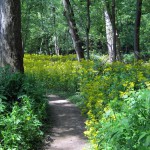Hello blog readers! I have been absent for some weeks due to my daughter’s graduation from UIndy (hurrah!) and an invited speaking engagement at the Brooklyn Botanical Garden. Now back to local flora.
Have you seen fallow farm fields of yellow flowers so dense they look like they must have been planted? The flower is butterweed (Packera glabella, used to be call Senecio glabellus). Other members of this genus are called ragworts.
Butterweed fills an area so thoroughly that it looks like an invasive non-native but it is in fact a native – but invasive. It is definitely on the increase in central Indiana and is showing up as a lawn weed on the Butler University campus. Marcia Moore and I took these photos along the White River at Southwestways Park in Indianapolis this week. We did not see this plant in the park when we inventoried the flora 8 years ago.
Butterweed’s striking yellow stands are beautiful. It is a member of the aster or daisy family. Both the disc and ray flowers are yellow. Leaves are pinnately divided (like a feather) and the stems are large and hollow, often with vertically running ridges.
It has little tuffs of hairs like dandelions that help spread the seeds around. It is a winter annual or biennial and seems to prefer moist soil.
I have read that no-till farming may be one of the reasons this plant is on the increase. I do not know the origin of the common name but would like to hear any ideas.


